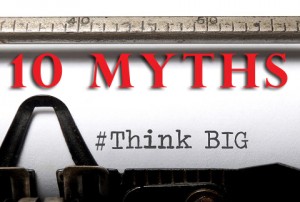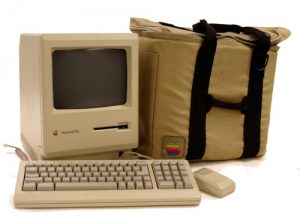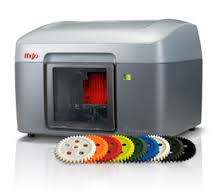 What is it that allows some people to seem to have a steady flow of Big Ideas while others seem to live in a desert devoid of creativity? It is the way men and women think. There are those that think they can, and those that think they can not. Both end up being right in the outcome. Do you want to break the chains that may be keeping you from Big Ideas? Then begin by casting off these 10 Myths About Big Ideas.
What is it that allows some people to seem to have a steady flow of Big Ideas while others seem to live in a desert devoid of creativity? It is the way men and women think. There are those that think they can, and those that think they can not. Both end up being right in the outcome. Do you want to break the chains that may be keeping you from Big Ideas? Then begin by casting off these 10 Myths About Big Ideas.
The Dime Myth About Big Ideas
How many times have you heard or even said to yourself or someone else, “Ideas are a dime a dozen.” I myself have made this statement entirely too many times. Even as someone who values ideas, and prides himself as being able to come up with great Big Ideas, I’ve used this statement.
But it’s a myth. Ideas are not cheap. Good ideas, even when they seem to just pop out of the air, can not be had for a dime a dozen. The problem with this myth is that it lessens the value of a good idea. It immediately decreases the potential of the imaginator and his idea.
People have a tendency to devalue things that aren’t paid for with cold, hard cash or blood, sweat, and tears. When the farmer stands at the edge of his furrowed field, a bag of seed at his feet, the value of that bag is equal to the value of his harvest. Without the seed of an idea, there is no harvest.
Begin to cherish and protect your ideas. Most importantly, plant them in fertile earth and prepare for the harvest.
The Harebrained Myth About Big Ideas
“Here comes another harebrained idea.” You’ve heard it before. You’ve probably used the term yourself when referring to a friend’s or colleague’s idea. Merriam-Webster defines harebrained as foolish, absurd, or ridiculous.
Many Big Ideas initially appear harebrained, at first glance. We’ve all heard of the Pet Rock, Tupperware, Post-It Notes, and Velcro. Big Ideas that weren’t initially seen as brilliant, that later became runaway best sellers or household names.
In order to overcome this myth, which is responsible for killing many good ideas, we need to embrace the brilliance of every idea. Only when ideas are welcomed with open arms can they turn into Big Ideas. By labeling an idea or an imaginator as harebrained, we can shut down the benefits embodied within the seed of the idea.
The Lack Myth About Big Ideas
Many people believe there is a limited supply of ideas. You may have heard of the statement made by Charles H. Duell, who was the Commissioner of the US patent office in 1899, “everything that can be invented has been invented.” Though this statement itself turns out to be a myth, according to PatentLYo.com, it shows up regularly in the conversation surrounding ideas and the promotion of creative thinking.
I’ve heard many times, “I can’t think of any Big Ideas.” “I’m not an idea person.” Statements like this suggest a limited quantity of available ideas, and that only other people can come up with good ideas. Personally, I don’t believe there is any shortage of good ideas, only of people willing to take a chance on an idea and bring it to life. All you have to do is spend some time online to see a continuous flow of ideas that will change the world. Some of these Big Ideas, like 3D printing, will change how we all do things on an everyday level.
The Uniqueness Myth About Big Ideas
 Many imaginators think that their idea is unique, that they can safely put it away to bring to life at a later date. I’ve learned that this is not true. I’ve learned that hard way that an idea not acted upon will fly on-and-on until someone takes action upon it.
Many imaginators think that their idea is unique, that they can safely put it away to bring to life at a later date. I’ve learned that this is not true. I’ve learned that hard way that an idea not acted upon will fly on-and-on until someone takes action upon it.
Two personal examples include an idea I had for a round refrigerator that would be a boon to men who don’t want to reach into the back of the refrigerator to find out what there is to eat. My idea would turn the refrigerator shelving into organized Lazy Susans, making it easy to access every item in the refrigerator.
Years later, while thumbing through a magazine, I saw my idea in full color. Someone else had created it.
Another example is connected to the iPhone. I owned one of the first iPhones on the market. At the time, I often listened to music using the phone’s built-in speaker. One day, while listening to music, I noticed that if I held my hand in the right positing the volume seemed to increase. I got in the habit of holding the phone in my open palm with a portion of my hand curved, allowing the sound to bounce back toward me instead of away from me.
Sometime later, I discovered a new project on Kickstarter run by a couple of guys who had discovered the same thing and actually created a solution with the same Big Idea. This confirmed to me that you can’t sit on an idea. They don’t like it. Eventually, they’ll get up and move to someone who will take them seriously.
The Good as It Gets Myth About Big Ideas
 Unfortunately, This is a myth by which many creative people and businesses live. It’s in the same family as “If it ain’t broke, don’t fix it.” This myth has actually been the death of many a once-thriving business.
Unfortunately, This is a myth by which many creative people and businesses live. It’s in the same family as “If it ain’t broke, don’t fix it.” This myth has actually been the death of many a once-thriving business.
Take Blockbuster, for example. They had a chain of video rental stores that was unbeatable in selection. They put many small video stores out of business. Their idea was to “make physical recordings of movies and games available for people to rent in our store.” Blockbuster saw the store idea and said we can do it bigger and better. They got into the “come into our store” rental business. And stopped there.
When DVDs became popular, Blockbuster stayed with the store idea. “Let’s make our customers come to us.” Then someone said, “We can do better. We can take our store to them.” Netflix was born. When Netflix was created, Blockbuster could have taken advantage of the same services, the internet, and the US Postal Service. But they didn’t. They stuck with their good idea. In the end, the belief that their idea was as good as it was going to get killed the giant retailer.
The Do It Later Myth About Big Ideas
This myth is the brother of The Uniqueness Myth. Putting off a good idea until later can cost an individual or business millions in lost revenue. Many ideas are good for only a short time. If not acted upon right away, new technology can come along and make them obsolete.
Kodak is an example of “The Do It Later Myth”. Kodak said “We’ll get into digital later if it proves valuable. People have been using film for decades. They won’t change. Film is so much better than digital.” Where is Kodak today? They tried to get in later, but it was too difficult. Other companies had already invested in the new digital technology for years and their costs were down as a result. Kodak came in with inferior products at a higher cost.
Beware, many ideas have a limited lifespan. If you wait too long, their value dissipates and even disappears.
The Simplicity Myth About Big Ideas
This myth says, “Ideas are easy to come up with. Anybody can do it. Why even try.” True, some very good ideas have seemed to come out of nowhere. But many ideas have been developed with hard, focused effort. At first sight, the ideas we see around us seem very simple. Have you ever said, “Why didn’t I think of that?”
This myth also devalues the creative person. While creativity is a gift all have received, it is still of great value. Some people seem to be more able to come up with good ideas. Some see more inclined to turn the ideas into reality. Thomas Edison, for example, came up with a great many ideas. Some of his inventions originated in his mind, others came from colleagues and other sources. It was through hard work, collaboration, and persistence that Thomas Edison became one of the world’s greatest imaginators.
The Thief Myth About Big Ideas
This myth is not all make-believe. Piracy is alive and well today. China continues to knockoff ideas left and right despite patents. This is very discouraging to inventors. It can be very deadly to a business to have the market flooded with imitations. But the real danger of this myth is that thinking that “Someone will steal my idea” has kept many ideas from even being attempted.
I’ve met authors who didn’t write because they didn’t want someone to steal their book idea. Screenwriters that didn’t write the screenplay because someone would steal their movie idea. People who live by this myth are actually stealing from themselves. They steal the opportunity the might have benefited from had they brought their idea to fruition.
Someone may be able to steal some of your ideas, but they can’t steal your passion. They can’t steal your knowledge. No one can steal your level of commitment.
The Someone Else’s Idea Myth About Big Ideas
 “Somebody already thought of that. There’s nothing I can do to make it better.” Many of the products we use today were originally conceptualized first by a different inventor. This myth is the opposite of the “If you build a better mousetrap, the world will beat a path to your door.”
“Somebody already thought of that. There’s nothing I can do to make it better.” Many of the products we use today were originally conceptualized first by a different inventor. This myth is the opposite of the “If you build a better mousetrap, the world will beat a path to your door.”
While the mousetrap analogy is a bit oversimplified, many inventors have been successful by reinventing ideas in a better way. Google wasn’t the first search engine. But they did it better, and the world beats a path to their door every day. Apple wasn’t the first personal computer. But they did it better, and the world beats a path to their door.
If you know you can do it better, you probably can. If your idea is just to do it differently, you may not succeed unless your “difference” makes your idea more cost-efficient. The Japanese didn’t originally make better cars, their ideas weren’t better, but they became competitive because they learned how to do it differently.
These ideas at first seemed simple. “Let’s make a computer, too.” “Let’s make cars to sell to America.” The development of these better ideas requires many more difficult ideas to be created. Within the tiny acorn lies the mighty oak.
The Can’t Be Done Myth About Big Ideas
This is probably one of the most encountered myths of all. “Great idea, but it can’t be done.” “We’d like to do that, but it can’t be done.” How many times have you said, “It can’t be done”? This myth has been busted so many times, I’m amazed we still use these words.
Can’t sail around the world. Done. Can’t go to the moon. Done. Can’t jump across the Grand Canyon. Done. Can’t go to Mars. I imagine they’ll get that done too. (This article was written before Elon Musk came onto the scene with his mission to Mars idea.)
Henry Ford said, “If you think you can do a thing or think you can’t do a thing, you’re right.” Which one do you want to be right about? Do you think you can write a best selling novel? You can. Do you think you can turn your idea into the Next Big Idea? You can. Do you think you can go into space as a space tourist? You can do that too.
Napoleon Hill said, “What the mind of man can conceive and believe, it can achieve.” For all the ideas that people have had and said “can’t be done”, there have been others who have said, “How can it be done?” Which one will you choose to be?
 Recently, I have seen a resurgence in the topic of Faith in the Workplace. Just this week I participated in a training session with Sandi Krakowski, social media guru, and founder of A Real Change International, Inc. Over the past year or so, I have watched Sandi bring her faith to the forefront of her business.
Recently, I have seen a resurgence in the topic of Faith in the Workplace. Just this week I participated in a training session with Sandi Krakowski, social media guru, and founder of A Real Change International, Inc. Over the past year or so, I have watched Sandi bring her faith to the forefront of her business. The great and wise Solomon once said, “There’s nothing new under the sun,” and he meant nothing, not even new ideas.
The great and wise Solomon once said, “There’s nothing new under the sun,” and he meant nothing, not even new ideas. What is it that allows some people to seem to have a steady flow of Big Ideas while others seem to live in a desert devoid of creativity? It is the way men and women think. There are those that think they can, and those that think they can not. Both end up being right in the outcome. Do you want to break the chains that may be keeping you from Big Ideas? Then begin by casting off these 10 Myths About Big Ideas.
What is it that allows some people to seem to have a steady flow of Big Ideas while others seem to live in a desert devoid of creativity? It is the way men and women think. There are those that think they can, and those that think they can not. Both end up being right in the outcome. Do you want to break the chains that may be keeping you from Big Ideas? Then begin by casting off these 10 Myths About Big Ideas.
 Unfortunately, This is a myth by which many creative people and businesses live. It’s in the same family as “If it ain’t broke, don’t fix it.” This myth has actually been the death of many a once-thriving business.
Unfortunately, This is a myth by which many creative people and businesses live. It’s in the same family as “If it ain’t broke, don’t fix it.” This myth has actually been the death of many a once-thriving business.
 A few years ago I noticed several 3D Printer projects on the crowd funding site
A few years ago I noticed several 3D Printer projects on the crowd funding site 
